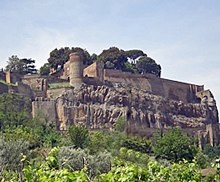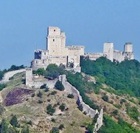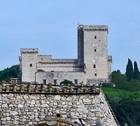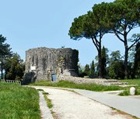

Ugolino di Petruccio da Corbara, Conte di Montemarte belonged to a noble family from Orvieto. He is first documented in 1342 as an ally of the anti-papal faction known as the Malcorini, when he escaped arrest by Matteo Orsini in Piazza del Popolo, and fled from the city. He was able to return to Orvieto only on a few occasions, and only for brief periods, before being driven once more into exile. This situation persisted until 1352, when the papal rector, Nicolò della Serra managed to unite the warring factions. Unfortunately, Orvieto soon fell to Archbishop Giovanni Visconti of Milan, who installed Giovanni di Vico as Lord of Orvieto.
Papal Service under Cardinal Albornoz
Ugolino di Montemarte was appointed Capitano di Guerra by Florence in May 1353, and joined the forces of Cardinal Gil Albornoz, with Florentine blessing, in October. From this point, he emerges as a diplomat and military architect rather than as a soldier, and was to remain faithfully in papal service for the rest of his life.
Ugolino da Montemarte was involved in the papal capture of Orvieto from Giovanni di Vico in 1354, and might well have begun the construction of a fortress there soon after (see below). In 1356, when he was appointed papal vicar of Ancona, he began the construction of the fortress of San Cataldo there, probably to his own design, and supervised some 1,000 workers.
In 1357, at the end of Albornoz’ first legation, the new papal legate, Androin de la Roche appointed him (together with the papal treasurer, Bartolo dei Ruini) to reform the statutes of Terni after its brief rebellion against papal control.
Albornoz appointed Ugolino da Montemarte as rector of the Duchy of Spoleto in 1360. He was documented in Spoleto in April 1360. He was present, together with Albornoz and Blasco Fernández de Belvis, at the provincial parliament held in Spoleto on April 22, 1361, at which (inter alia) a tax was imposed on the citizens of the city in order to finance the construction of the papal fortress there.
Ugolino da Montemarte participated in the construction of the fortress at Orvieto in 1364 (see below).
When Albornoz left for his new legation in Naples in August 1365, he named Ugolino da Montemarte as Lieutenant General for those parts of the original legation not transferred to Androin de la Roche, which included the Patrimony and the Duchy of Spoleto.
Albornoz returned to the Patrimony after less than a year. Ugolino da Montemarte defeated the mercenary army of John Hawkwood outside the city in 1366, setting of a train of events that led to Hawkwood’s victory over Perugia in 1367, which allowed Albornoz to seize full control in the Duchy of Spoleto.
Ugolino da Montemarte was leading the papal assault on Todi when Albornoz died at Viterbo, and he attended Albornoz’ funeral there.
Papal Service after Albornoz
Ugolino di Montemarte was one of the ambassadors that the Commune of Orvieto sent to Viterbo to offer the lordship of the city Pope Urban V. He was offered the post of Senator of Rome, but preferred to serve the papal cause as a soldier.
When Blasco Fernandez di Belviso, a nephew of the recently-deceased Cardinal Albornoz, was murdered in 1367 at Piediluco, Ugolino di Montemarte was sent to round up the rebels and reap vengeance. In 1368, he was appointed Lieutenant of Assisi and fought a battle against the Perugians.
In 1370, he was instrumental in negotiating peace between the Perugians and Pope Gregory XI. After the expulsion of the Raspanti in 1371, the government of Perugia effectively passed to the papal legate, Cardinal Pierre d' Estaing. He appointed Ugolino da Montemarte as Vicar and Lieutenant General of Perugia (May 1371). When he was transferred to Bologna in December 1371, Ugolino da Montemarte remained in Perugia in the service of his successor, Cardinal Philippe de Cabassole (Filippo di Calassol). Ugolino da Montemarte was in Perugia when Cardinal Philippe de Cabassole died there (August 27, 1372).
Ugolino da Montemarte returned to defend Assisi for the papacy in 1375, in the War of the Eight Saints. He was appointed papal vicar of Todi in 1377, helped the Chiaravalle to return and exiled the Atti. [Construction of the Rocca]
The newly elected Pope Urban VI appointed Rinaldo Orsini as governor of Orvieto in 1378. However, in 1380, Orsini declared for the anti-Pope Clement VII. Ugolino di Montemarte remained faithful to Urban VI, but died in 1388, some two years before Orsini was murdered and Orvieto returned to papal control.
Orvieto
Rocca dell’ Albornoz (1364)

The defences of Orvieto were judged to be inadequate when a freelance mercenary known as Anichino di Baumgarten menaced the city in 1364. Cardinal Albornoz sent Giordano del Monte degli Orsini, who held the post of Capitano del Patrimonio, to strengthen them. A document in the archives of Orvieto records that work began in September 1364, at the expense of the Commune and under the supervision of Ugolino di Montemarte.
Assisi
Fortresses (1362-5)

Narni
Rocca (1367-78)

Todi
Rocca (1373)
In 1352, the Chiaravallesi and Giovanni di Vico tried unsuccessfully to take power in Todi. They returned to the attack in 1353 using the mercenaries of Fra Moriale, but again the Guelfs, aided by Perugia and encouraged by Cardinal Albornoz, held firm. In 1356, Pope Innocent VI was forced once more to plead for help from Perugia in repelling another Ghibelline attack on Todi, despite their strained relations. Andrea degli Atti was installed as papal vicar, and he succeeded in restoring ecclesiastical control. In 1367, during the short stay in Italy of Urban V, Cardinal Albornoz finally subjected Todi to direct papal control, despite the intercession of Florence. He took over the Convento di Santa Maria di Montesanto from the Poor Clares and used the site to build a fortress.

The people of Todi tore it down in 1382.
Braccio Fortebraccio commissioned Giovanni di Santuccio (the project manager in charge to the work at San Fortunato) to rebuild this second fortress in 1423. Pope Paul II strengthened it in 1464 and again in 1471. Pope Innocent VIII appointed Bartolomeo d’ Alviano as castellan in 1487 when he had expelled the Ghibellines, and d’ Alviano undertook further strengthening of its defences. Pope Sixtus IV laid siege to it in 1495: his army included his nephew, Giuliano della Rovere, the future Pope Julius II.
Lodovico degli Atti lay siege to the fortress in 1503 and finally destroyed it. The remains were reused at Santa Maria della Consolazione. Today, only the lower part of a single majestic tower (il Mastio) survives on the site.

